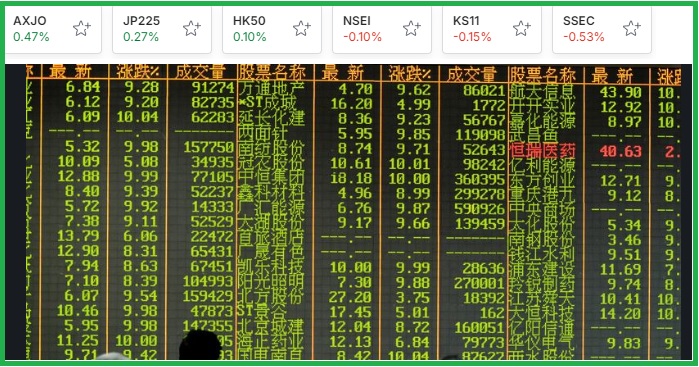
(Photo : Asian markets)
- Asian markets surged to a two and a half year high due to Chinese stimulus measures and U.S. rate cut expectations.
- China's top financial regulators announced measures including a 50 basis point cut in bank reserves and a reduction in mortgage rates.
- The Chinese stock market responded positively, with the CSI300 Index and Shanghai Composite Index both opening 1% higher.
- Investors are now closely watching the Reserve Bank of Australia's policy decision and the Federal Reserve's potential rate cut in November.
Asian markets experienced a significant surge on Tuesday, reaching their highest levels in over two and a half years. This surge was primarily driven by a series of stimulus measures introduced by China, coupled with expectations of further rate cuts in the U.S. These factors have kept risk sentiment high and put the U.S. dollar under pressure.
In a highly anticipated move, China's top financial regulators announced a series of measures aimed at stimulating the country's economy. These measures included a 50 basis point cut in bank reserves and a reduction in mortgage rates. The goal of these measures is to spur economic growth, which has been sluggish in recent times.
The announcement of these measures had an immediate impact on the Chinese stock market. The blue-chip CSI300 Index opened 1% higher, while the broader Shanghai Composite Index also saw a 1% increase at the open. This positive response to the stimulus measures reflects the market's confidence in the potential of these measures to boost economic growth.
China's Stimulus Measures Boost Asian Markets
Hong Kong's Hang Seng Index also reacted positively to the news, jumping over 2% in early trading. The mainland properties index saw an even more significant surge, increasing by 5%. This surge in the Hong Kong market is indicative of the broader impact of China's stimulus measures on the Asian market.
The positive impact of China's stimulus measures was also felt in other parts of Asia. MSCI's broadest index of Asia-Pacific shares outside Japan rose by 0.41% to 588.43, a level last seen in April 2022. This rise in the index reflects the positive sentiment in the Asian market following the announcement of China's stimulus measures.
Khoon Goh, head of Asia research at ANZ, commented on the impact of the stimulus measures. He said, While there was some anticipation that stimulus measures would be announced after they mentioned there was going to be a press briefing, the package of measures so far, I would say, is probably larger than what the market was expecting.
Investors Eye Reserve Bank of Australia's Policy Decision
In addition to the Chinese stimulus measures, investors are also closely watching the Reserve Bank of Australia's policy decision. The bank is widely expected to maintain its current rates, although the Federal Reserve's 50 basis point cut last week has raised some expectations that Australia could follow suit.
Charu Chanana, head of currency strategy at Saxo, said, "The RBA is likely to stick to its hawkish stance for now, aiming to keep inflation expectations anchored. A potential pivot may come only at the Nov. 5 meeting depending on further labour market data and the Q3 CPI report."
Japan's Nikkei was the biggest mover in early trading, soaring 1.4% to a near three-week high. This surge came ahead of an eagerly awaited speech by Bank of Japan Governor Kazuo Ueda. The market is keenly awaiting Ueda's speech for any indications of potential changes in the Bank of Japan's policy.
Meanwhile, in the U.S., stocks closed modestly higher as traders continued to digest the Federal Reserve's significant move last week. The Fed cut its rates by 50 basis points, a move that was explained by policymakers as necessary given the current economic conditions.
The market is currently split on whether the Fed will opt for another 50 basis point cut or a 25 basis point cut in November. The CME Fedwatch tool showed that the market is pricing in 76 basis points of easing this year.









